Morel mushroom hunting in North Dakota is all about timing and location. The season is short, lasting only a few weeks, and if you’re not prepared, you’ll miss it. With morels selling for over $50 a pound, it pays to be efficient.
The challenge is knowing where to start. North Dakota’s landscape is wide and varied, and without direction, it’s easy to waste time in the wrong places. Getting help to narrow things down can make the difference between a slow hunt and a productive one.
Success comes from knowing which areas are worth checking and when. You won’t find morels by wandering at random. That’s why it’s important to learn where these mushrooms actually show up in the state.
What We Cover In This Article:
- What Morel Mushrooms Look Like
- Mushrooms That Look Like Morels But Aren’t
- How To Find Morels
- Where You Can Find Morels
- Additional locations to find Morels
- When You Can Find Morels
- The extensive local experience and understanding of our team
- Input from multiple local foragers and foraging groups
- The accessibility of the various locations
- Safety and potential hazards when collecting
- Private and public locations
- A desire to include locations for both experienced foragers and those who are just starting out
Using these weights we think we’ve put together the best list out there for just about any forager to be successful!
A Quick Reminder
Before we get into the specifics about where and how to find these plants and mushrooms, we want to be clear that before ingesting any wild plant or mushroom, it should be identified with 100% certainty as edible by someone qualified and experienced in mushroom and plant identification, such as a professional mycologist or an expert forager. Misidentification can lead to serious illness or death.
All plants and mushrooms have the potential to cause severe adverse reactions in certain individuals, even death. If you are consuming wild foragables, it is crucial to cook them thoroughly and properly and only eat a small portion to test for personal tolerance. Some people may have allergies or sensitivities to specific mushrooms and plants, even if they are considered safe for others.
The information provided in this article is for general informational and educational purposes only. Foraging involves inherent risks.
What Morel Mushrooms Look Like
The first thing you need to know if you want to be a successful morel hunter is what these mushrooms generally look like. There are several different types to look out for and they have certain differences that set them apart from each other:
Grey Morels
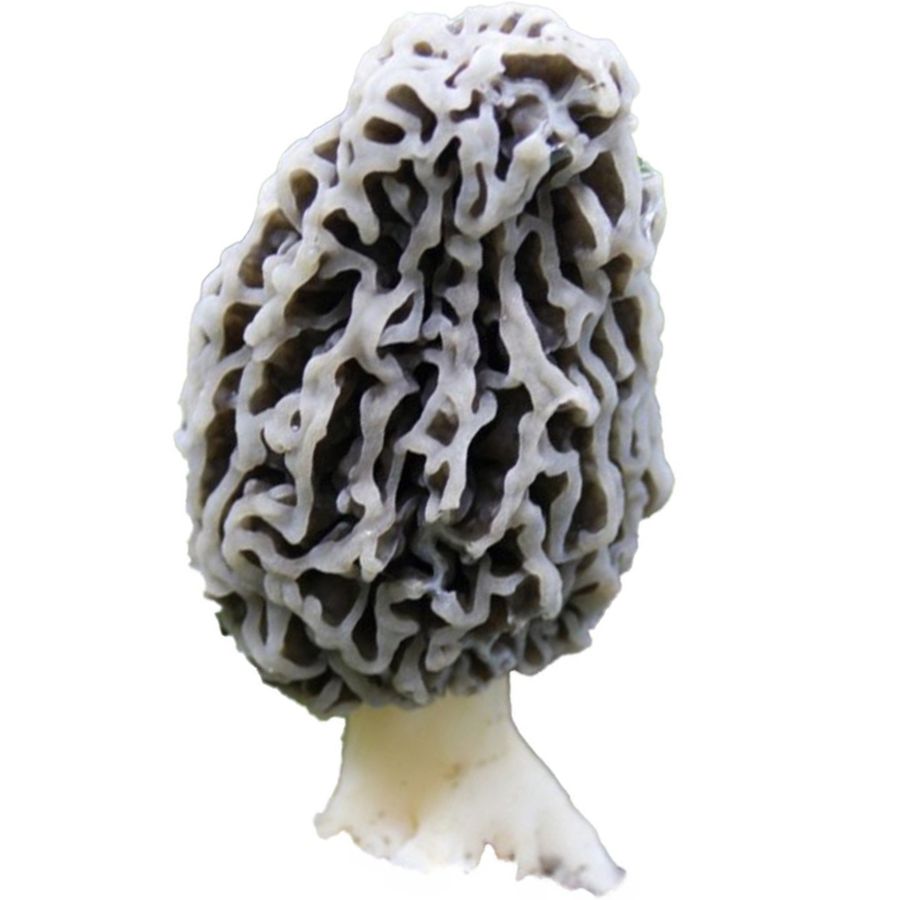
Grey morels (Morchella tomentosa) are also called fuzzy foot or fire morels. Their color can range from deep gray to blackish. They tend to grow in areas that have recently experienced wildfires, as they thrive in the nutrient-rich soil left behind by the fires.
Their caps have a ridged, honeycomb-like texture, similar to other morels. However, grey morels have caps that are covered in fine, fuzzy hairs, so they generally feel velvety to the touch. This is a key thing that sets them apart from other types of morels.
The stem of a gray morel also tends to be stouter and thicker, with an off-white color that can sometimes have a yellow-tinge. In addition, its flesh also tends to be denser compared to the more delicate flesh of yellow morels.
Cream or Yellow Morels
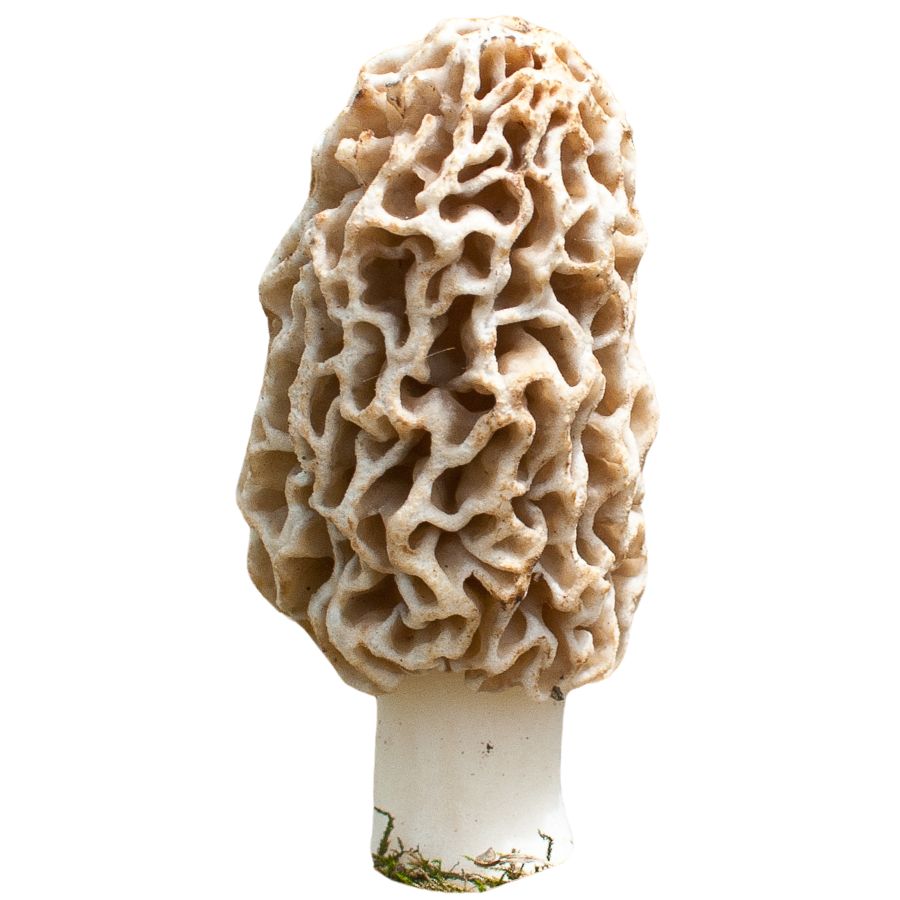
Yellow morels (Morchella esculenta), also known as common, cream, or sponge morels, are named for their yellowish or tan-colored caps. These morels have a honeycomb-like appearance, with deep ridges and pits. The ridges also tend to stay just a bit darker than the rest of the cap.
Pay close attention to the cap of the mushroom. The caps of yellow morels are characteristically fuller and rounder or oval-shaped. Also, their stems are hollow with a wide base and a pale creamy color.
This morel variety commonly grows in hardwood forests, especially near deciduous trees like ash, elm, and oak. They’re also one of the first morel varieties to appear in the spring.
Keep in mind that yellow morels start out with a more grayish appearance, gradually turning yellow as they grow older. This means that if you come across grayish morels in a hardwood forest, then they might be yellow morels that still need to mature.
Black Morels

Black morels (Morchella angusticeps), sometimes called eastern black morels, are a distinctive variety of morel mushrooms known for their dark, almost black caps. Their caps have the same honeycomb-like surface seen in other morels, but they are often taller and more slender.
You can also expect the ridges of this morel type to be noticeably darker than the pits. The stem can be off-white to pale yellow, and is typically wrinkly with a wider base.
This morel variety is often found in hardwood forests and old orchards. They thrive in moist soil and areas around decaying trees and plants as well as areas near streams and creeks. While they grow in moist environments, they don’t like overly wet soil.
You can also expect to black morels in the early to mid-spring, and they emerge just a bit earlier than yellow morels.
For a full overview of what wild mushrooms are easy to recognize, check out this resource on easy-to-identify wild mushrooms.
Mushrooms That Look Like Morels But Aren’t
Now that you have a better idea of what to keep an eye out for when you’re hunting for morels, you’ll also need to know which mushroom species you have to avoid.
Consider exploring foraging for survival strategies that include avoiding toxic lookalikes.
These mushroom species may look a lot like morels, but they’re not morels. Here are the morel lookalikes that you need to be able to identify:
Early Morel – Verpa bohemica
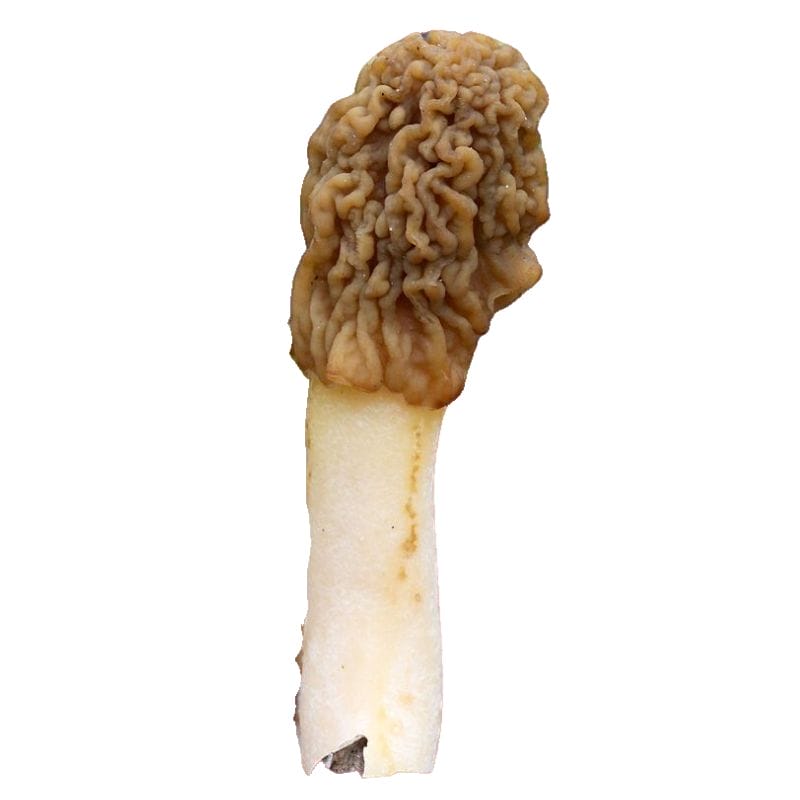
True to its name, the early morel (Verpa bohemica) is a morel lookalike that also emerges early in the spring. A lot of the time, it emerges even before true morels do! Add the fact that it looks like a morel to the unsuspecting eye, and it’s understandable that people often confuse it with the real thing.
The cap of the early morel is light brown or tan and looks kind of like a wrinkled thimble. It doesn’t have the distinctive ridges and deep pits that true morels have. The cap is also attached only to the top end of the stem, with the sides hanging over the stem, much like a bell.
Another difference between early morels and true morels is that early morels tend to have stems with fibers that look like cotton inside. The stems of true morels are generally hollow.
Can you eat the Verpa bohemica? The answer is…controversial, to say the least. Some say that these mushrooms are absolutely delicious and taste a lot like true morels. Others say that it’s fine and good enough to eat if you cook it for a long time. There also are those who only eat the stems and dispose of the caps.
In recent years, however, respected experts like Noah Siegel and Christian Schwarz, authors of Mushrooms of the Redwood Coast, have re-evaluated these fungi. They now list Verpa conica and Verpa bohemica as plain old “edible”—no scare quotes, no special warnings.
Globally, Verpa mushrooms are commonly eaten and even sold commercially without issue. Much of the lingering stigma seems to stem from U.S.-based caution, often due to a lack of deeper knowledge. For a thorough look at this debate, check out the detailed coverage by Fungi Magazine.
Bell Morel – Verpa Conica
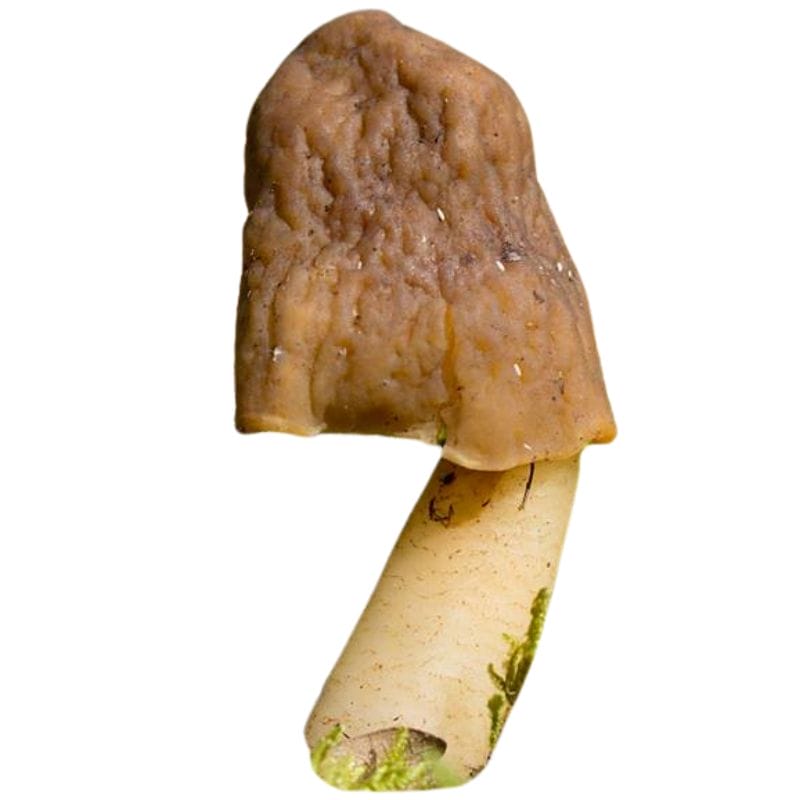
Like early morels, the bell morel (Verpa conica) is also easy to confuse as a true morel. However, it does have a few distinguishing characteristics.
Notably, the cap of bell morels is more similar to the cap of early morels. The cap is attached only to the top end of the stem, with the sides hanging down. It looks a lot like a bell — hence the name!
However, unlike the cap of early morels, the cap of bell morels doesn’t have a wrinkled appearance.
The stem of the bell morel is white to pale yellow, and also longer and narrower compared to the stems of true morels and early morels. It also has a smoother and more fibrous texture, though it has a similar cottony interior as early morel stems.
As a general rule, bell morels should be cooked thoroughly before consumption. If you’re eating it for the first time, it’s best to only eat small portions at first to test your tolerance and avoid gastrointestinal issues.
False Morel – Gyromitra esculenta

False morels (Gyromitra esculenta) are a type of mushroom that you definitely need to watch out for. It’s a toxic mushroom that unfortunately looked quite similar to true morels. Luckily, there are key differences between true and false morels that can help you set the two apart.
One thing that you might be able to notice right away is the appearance of the cap. The cap of a false morel is wrinkled, not sharply ridged and pitted like the cap of a true morel. You’ll also notice that false morel caps are wider where true morel caps are narrower.
Overall, false morels look a lot like brains.
In addition, false morels have a reddish brown to dark brown color, sometimes tinged with yellow or tan. The stem also tends to be short and thick, with an off-white to yellow color and a cottony, fibrous interior.
An important characteristic that sets false morels apart from true, early, and bell morels is that false morels are hollow but chambered. True, early, and bell morels are hollow all throughout. False morels, meanwhile, have several hollow pockets inside of them.
Perhaps the most important thing to remember about false morels is that they’re known to be toxic, especially when they’re raw. They contain a compound called gyromitrin, which breaks down into monomethylhydrazine (MMH) when consumed. MMH can affect major organs in the body and cause severe poisoning.
There are those who still consume false morels after extensive cooking and preparation, but it’s important to keep in mind that these mushrooms can still be highly toxic even when cooked. Thus, it’s best to stay away from false morels and to leave them be when you encounter them.
Stinkhorn

Stinkhorns are a group of mushrooms that certainly live up to their name. Aside from their distinctive appearance, they also have a distinctive smell. They have a strong, foul odor that’s often compared to the smell of rotting meat or even sewage. In fact, the smell alone can help you distinguish them from true morels.
Several stinkhorn species have a slimy mass on their caps. This mass is the gleba, or the spore mass. Because stinkhorns emit a foul, rotting smell, the often attract flies that then carry off the spores and spread them.
The caps of stinkhorns themselves are often slimy to the touch as well, as opposed to the dry caps of true morels. Depending on the species, stinkhorn caps can be pointed, rounded, or latticed. Stinkhorn are also soft and spongy, while true morel caps are firmer.
You can also differentiate between stinkhorns and true morels based on their habitats. While true morels generally thrive in hardwood forests and post-burn areas, stinkhorns grow in things like mulch, compost, and areas with decaying wood. They also prefer warm and humid environments.
How To Find Morels
Let’s get more specific and break down the different conditions in which morels can typically be found:
Know your trees if you want to find morels
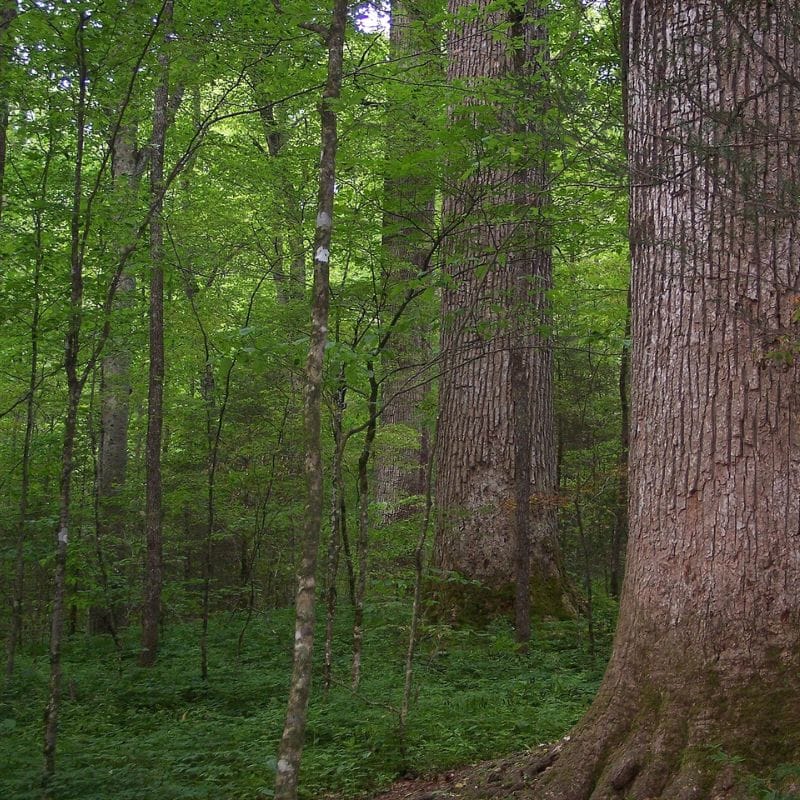
The most common type of trees associated with true morels are hardwood trees. You’ll often find morels at the base of these trees, around fallen leaves, or near decaying roots.
Keep an eye out for the following tree types:
- Apple
- Ash
- Aspen
- Douglas Fir
- Elm
- Oak
- Peart
- Ponderosa Pine
- Sycamore
- Tulip Poplar
- White Pine
If you need a refresher on how to identify these, you can check out this article on how to identify the trees morels love here.
Loamy or moist and well-drained soils around these trees are usually the best spots where morels can be found.
Coniferous trees are often associated with morels, though these are for fire-associated varieties. You can search for morels in conifer forests in the aftermath of a fire.
Moist soil near creeks and streams are ideal

You’ll also be able to find morels in rich, moist soils near streams and creeks, especially those on hillsides.
However, it’s important to note that the area should have well-drained soil. That’s the type of soil that morels thrive in. You’re far less likely to find these mushrooms in wet, inundated soil.
Thus, when you’re near a stream or creek, try to go a bit farther away and look for spots where the soil drainage is much better.
Seek Out Old Apple Orchards

Morels notoriously thrive in old apple orchards, especially orchards in regions where apples have been historically cultivated. This is because morels are known to favor areas with decaying organic matter from dead or dying trees, and apple orchards are a prime candidate.
These old orchards often have decaying apple tree roots. The soil there is also often rich in nutrients and is well-drained, forming a great environment for morels to form.
Additionally, apple orchards have disturbed ground as a result of tilling and the removal of trees. This is yet another condition that morels prefer.
However, one caveat is that old apple orchards, especially those from the early to mid-20th century, were typically treated with pesticides like DDT and lead arsenates. These pesticides have been banned, but they’re still a concern. DDT takes a long time to break down, and lead isn’t biodegradable at all.
Thus, old apple orchards might be contaminated with these pesticides.
If you’re looking to broaden your spring foraging knowledge, these simple foods to forage in spring can be found in many of the same environments as morels.
Soil temperature is critical

Another environmental aspect that’s crucial for the growth of morels is soil temperature. Typically, the most ideal temperatures for morels to thrive are 50°F to around 55°F.
Morels might start appearing once temperatures reach around 48°F, continuing to thrive once temperatures are in the ideal range. They can still continue growing in the 55°F to 60°F range.
However, if temperatures rise too quickly, that might signal the end of morel season. Anything above 60°F will cause morels to begin to dry out and decay.
Focus on southward and westward slopes early in the season
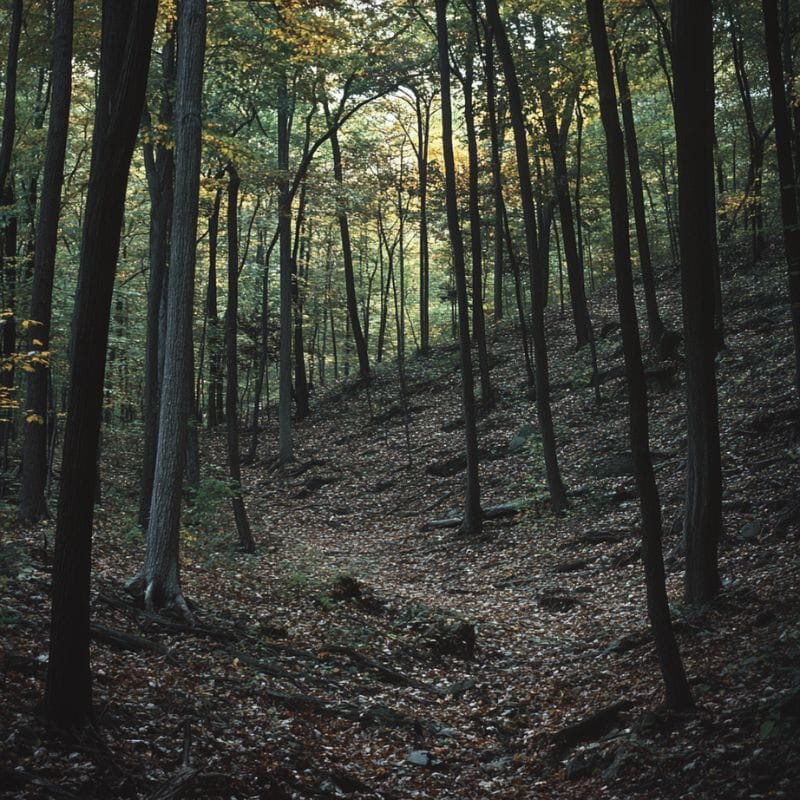
Morels tend to show up sooner on south- and west-facing slopes. This is because these slopes generally receive more direct sunlight, which makes them warm up faster in the spring. Thus, the soil here reaches the ideal 55°F to 60°F temperature range more quickly.
If you want to go morel hunting earlier in the season, you can check out south- and west-facing slopes. However, morels in these areas tend to be smaller and drier because of the higher temperatures.
Wait a little longer and you can hunt on north- and east-facing slopes. These areas won’t get as much direct sunlight and therefore warm up more slowly. Soils here also retain moisture much longer.
Thus, morels tend to be larger on north- and east-facing slopes, and they typically stick around for a longer period of time.
Burned areas are great for some morels
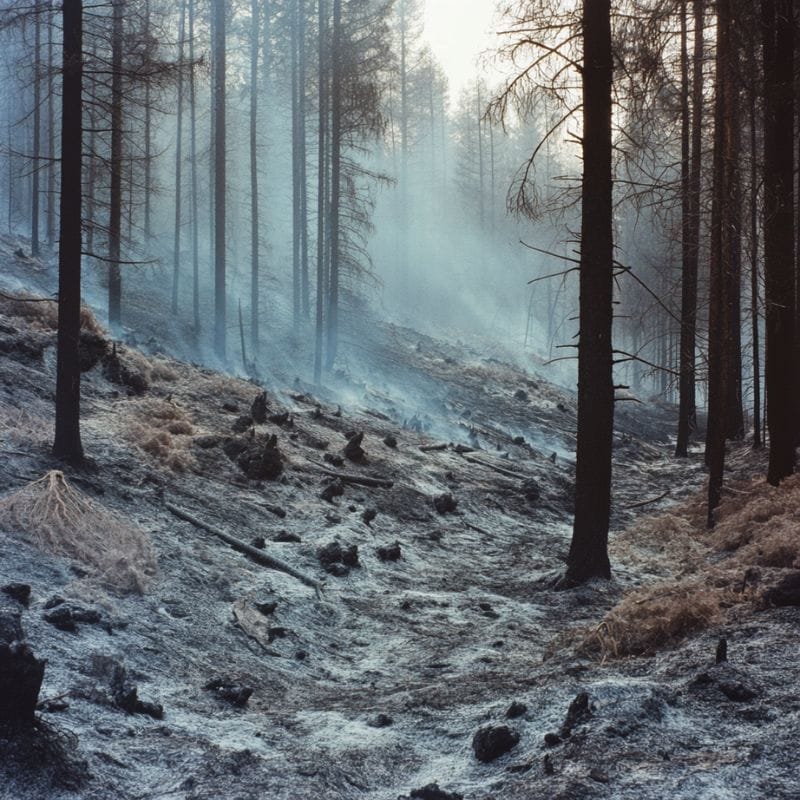
Burn areas are also a great place for morels to grow in, particularly those areas in the western US where wildfires occur frequently. You can expect morels to grow during the first spring following a wildfire.
Fire can give morels an advantage. For one thing, it can wipe out other fungi and plants that would compete with morels for nutrients. Morels also thrive in disturbed ground, of which there are plenty after a fire.
However, morels won’t thrive if the fire is too intense. The fire should just be intense enough that it can clear the forest floor without being so hot that it sterilizes the ground.
Tools from the ultimate forager’s toolkit can make searching in post-fire terrain much easier.
Rotting wood debris and leaves
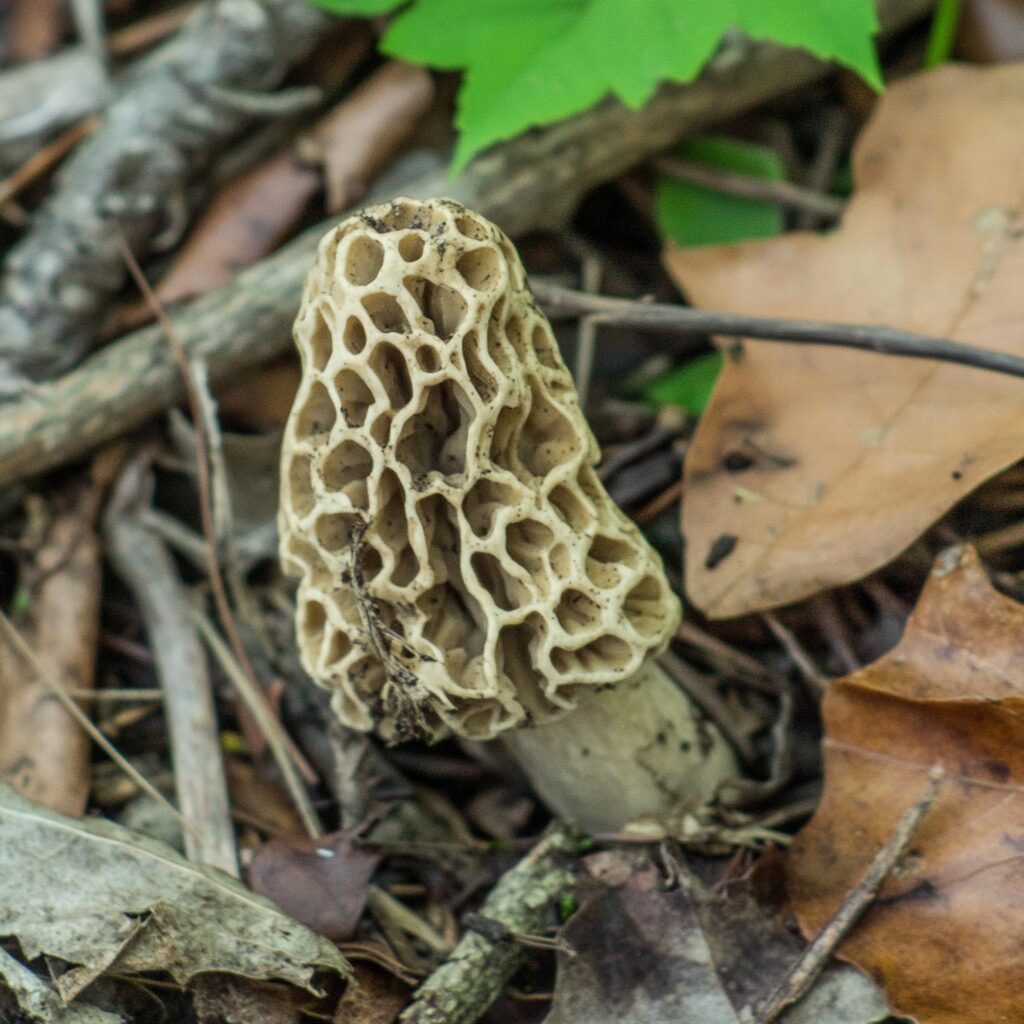
Look for spots where there are dead or dying trees, fallen branches, or fallen leaves. The roots and stumps of elm, poplar, ash, apple, and other types of hardwood trees in particular are also good places to look. These are prime spots for morels because decaying organic matter enables these mushrooms to thrive.
Decomposing leaves, wood, and roots release nutrients that fuel the growth of morels and other types of fungi. Decaying matter also holds the right amount of moisture that morels prefer.
When you see one there are often others nearby
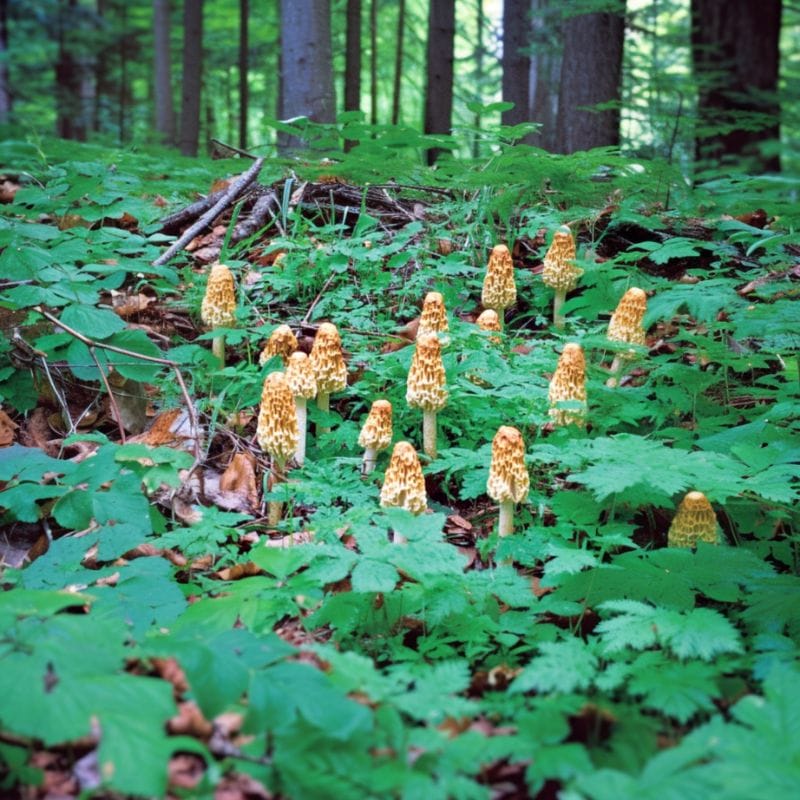
There’s rarely ever just one morel in a general area. Typically, they appear in small clusters. If you find one, it’s highly likely that there are more nearby, often within a distance of a few feet. You won’t find morels tightly packed together, but you won’t have to look far either for more specimens.
Morels can also return to the same spots year after year, though this is highly dependent on the conditions in the area. As long as all the right environmental conditions are there, you can come back to the same spots where you found morels every year. There will likely be more morels waiting.
It’s also possibly that these spots might shift slightly as time passes. Drastic changes, such as fires and floods, can also increase the chances of morels fruiting.
Old timers look to oak leaves and lilacs
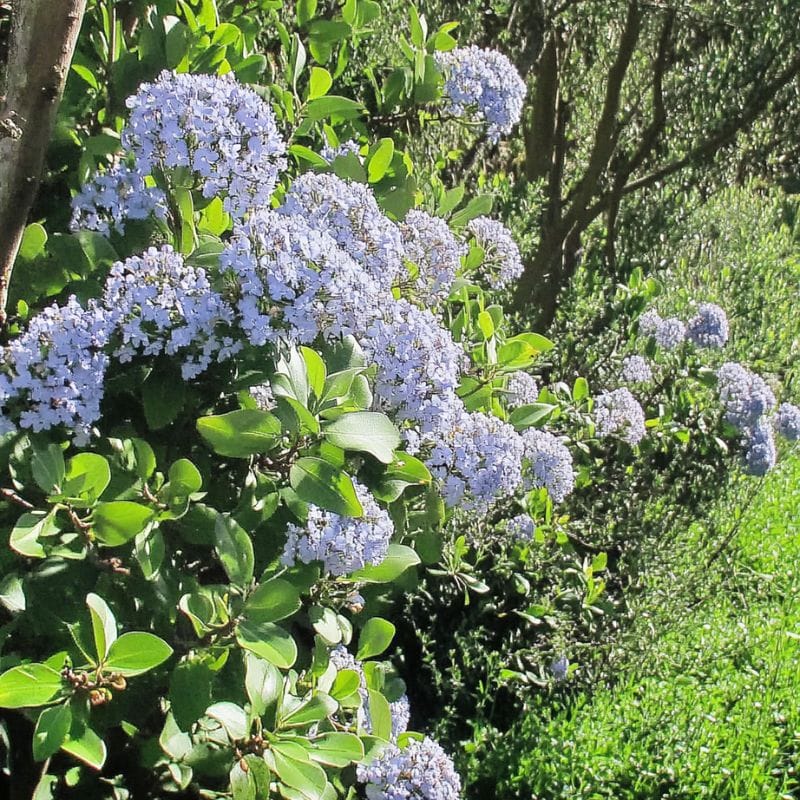
Experienced foragers will likely tell you to keep an eye out for lilac blooms. This is because the conditions needed for morels to grow and lilacs to bloom are generally aligned. You’ll likely hear that morel season coincides with the blooming of lilacs, especially in temperate areas.
The emergence of oak leaves is also a traditional indicator for morel season, and with good reason. Oak leaves come out when temperatures reach the 50°F to 55°F range, so morels are not far behind. Once these leaves are roughly the size of a mouse’s ear, it’s time to start looking!
Before you head out
Before embarking on any foraging activities, it is essential to understand and follow local laws and guidelines. Always confirm that you have permission to access any land and obtain permission from landowners if you are foraging on private property. Trespassing or foraging without permission is illegal and disrespectful.
For public lands, familiarize yourself with the foraging regulations, as some areas may restrict or prohibit the collection of mushrooms or other wild foods. These regulations and laws are frequently changing so always verify them before heading out to hunt. What we have listed below may be out of date and inaccurate as a result.
Where You Can Find Morels
Armed with the knowledge of the typical places where morels can be found, we can now take a look at the places where you can go mushroom hunting successfully.
If you’re hoping to find other spring edibles along the way, these easy-to-identify wild roots and tubers are often found in the same environments.
These are some of the best spots for morels in the state:
Beaver Creek Recreation Area
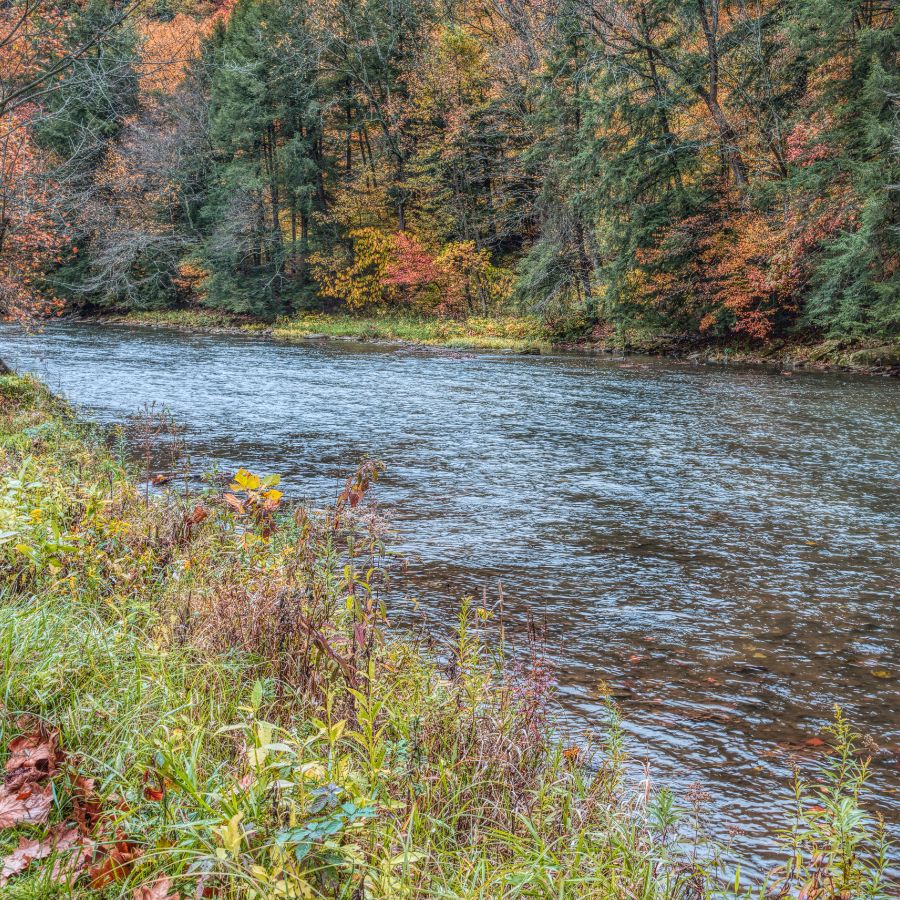
Beaver Creek Recreation Area nestles in western North Dakota, providing a serene escape characterized by rolling hills and wooded valleys. The flowing waters of Beaver Creek create a diverse ecosystem where morels thrive in spring.
Experienced hunters recommend focusing on the north-facing slopes where soil remains damp longer after spring rains. The decomposing leaf litter under deciduous trees provides excellent nutrition for emerging morels.
Look for natural depressions that collect moisture without becoming waterlogged, as these spots often harbor clusters of the elusive mushrooms. The riparian zones along Beaver Creek offer particularly rich hunting grounds, especially near dying elms or cottonwoods.
Don’t overlook the transition areas between woods and meadows, where diffused sunlight and protection from drying winds create perfect morel habitats. Remember to use a mesh bag for your findings to allow spores to spread as you continue your hunt.
Turtle River State Park
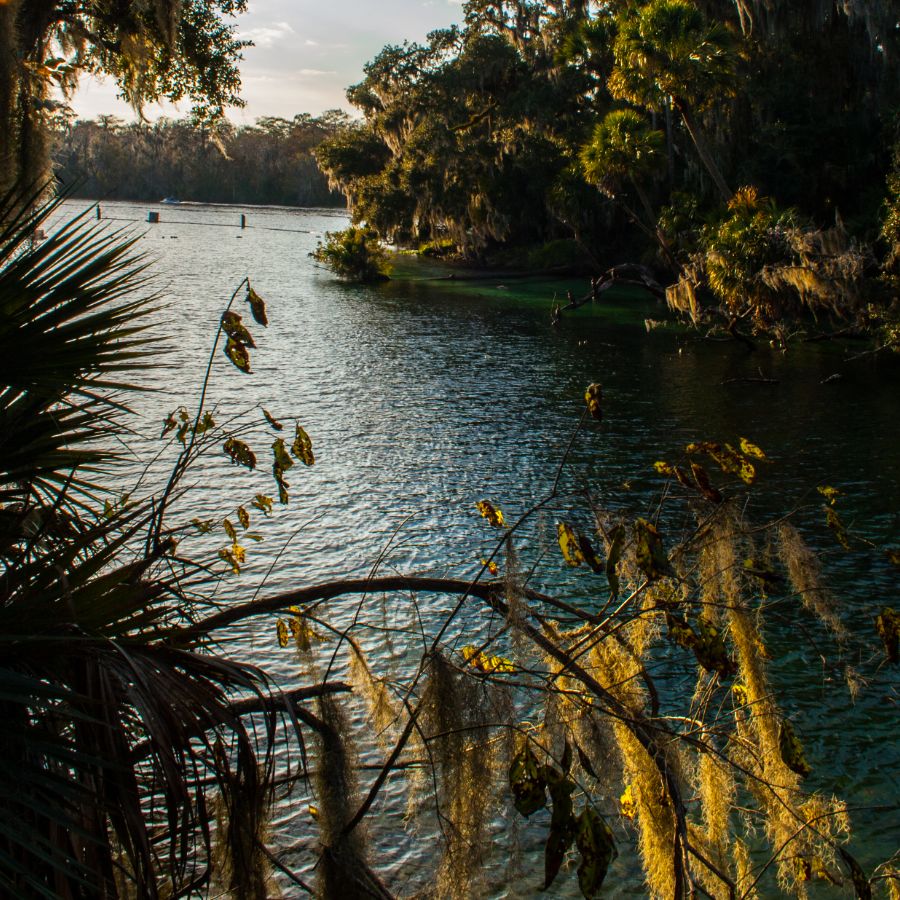
Turtle River State Park offers a woodland oasis just 20 miles west of Grand Forks in the Red River Valley. Unlike the surrounding flat farmland, this 784-acre park features dramatic ravines and hills carved by the winding Turtle River.
The unique topography creates sheltered microclimates where morels appear as soon as soil temperatures reach the ideal range. The park’s mature hardwood forests provide the perfect environment for morel growth, especially during the critical spring weeks when temperatures fluctuate between warm days and cool nights.
Morel hunting success at Turtle River often comes in areas with recent tree disturbance. The park’s numerous hiking trails provide excellent access to potential hotspots while minimizing impact on sensitive environments.
Small tributary streams joining the main river create particularly rich environments where decomposing organic matter feeds the underground fungal networks.
Sheyenne National Grasslands
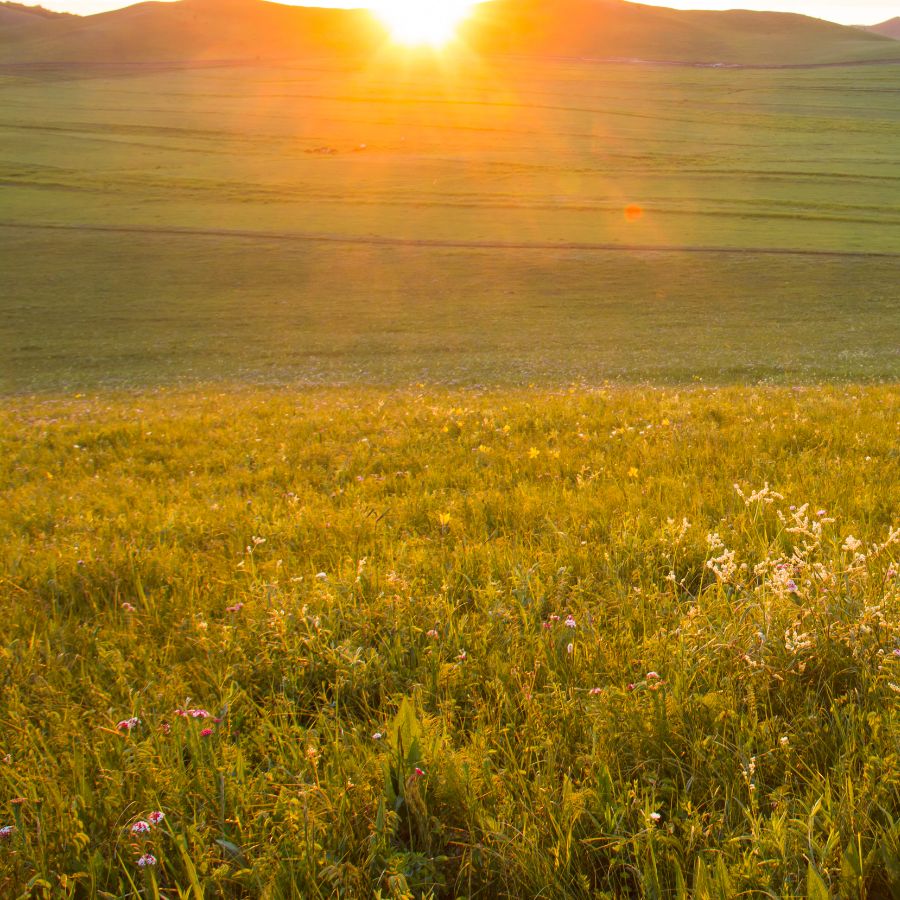
The Sheyenne National Grasslands spans approximately 70,000 acres in southeastern North Dakota, representing the state’s largest remaining tallgrass prairie ecosystem. This unique landscape sits atop an ancient river delta, resulting in sandy soils unlike those found elsewhere in the region.
The mix of open grasslands, oak savannas, and wooded river bottoms creates diverse habitats where morels appear each spring. Wildflowers dot the landscape, often signaling the perfect timing for morel emergence.
The Oak Leaf Trail leads to several wooded ravines where mushrooms frequently appear after warm spring rains. Moreover, the wooded corridors along the Sheyenne River hide some of the most productive morel grounds, particularly where cottonwoods and oaks predominate.
Cross Ranch State Park

Cross Ranch State Park preserves one of the last undeveloped stretches of the Missouri River, located in central North Dakota. The park’s 589 acres encompass pristine bottomland forests alongside undisturbed mixed-grass prairie.
Ancient cottonwoods, some over 300 years old, tower above the landscape, creating prime morel habitat beneath their canopy. The park’s relatively remote location means mushroom hunters often have areas entirely to themselves, especially on weekdays.
Bird watchers visiting Cross Ranch often discover morels while spotting the diverse wildlife that inhabits the park. The bottomland hardwood forests deserve thorough exploration, with particular attention to areas dominated by cottonwoods and green ash trees.
The park’s river access allows boaters to reach isolated shoreline areas that may harbor untouched morel patches. Explore the network of hiking trails that wind through potential hunting grounds without requiring difficult off-trail navigation. Check soil temperature rather than calendar dates to time your hunt perfectly.
Little Missouri National Grassland
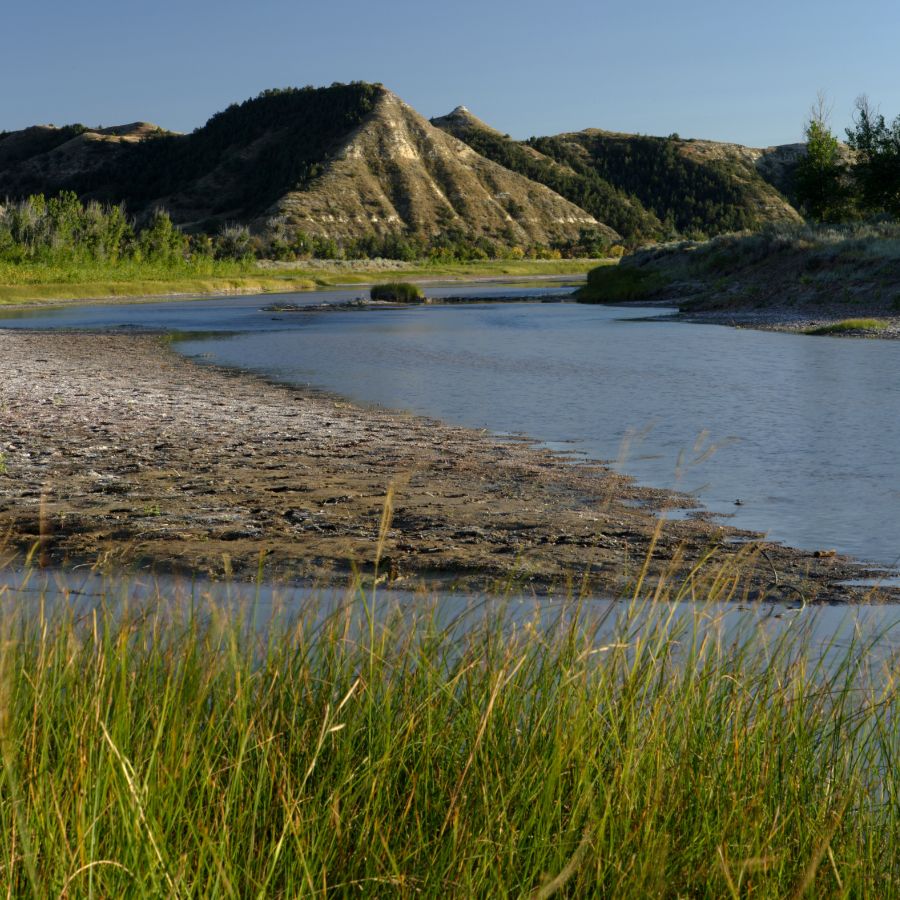
Little Missouri National Grassland dominates western North Dakota as America’s largest public grassland, spanning over one million acres. Scattered wooded draws and river bottoms throughout this vast area create sheltered environments where morels thrive during spring.
The Maah Daah Hey Trail provides access to remote areas where few mushroom hunters venture. Concentrate your search in woody draws where ash, elm, and cottonwood trees grow, providing both nutrients and shade.
Previously burned areas often produce spectacular morel fruitings in the following spring, so check with rangers about recent prescribed fires.
Morning hunts prove most productive as the angled sunlight helps highlight the distinctive pattern of morel caps against the forest floor. Always carry plenty of water and navigation tools, as the vastness of the grassland makes it easy to lose orientation.
Additional locations to find Morels
| Northeast North Dakota | Collection Details |
|---|---|
| Cavalier County Wildlife Management Areas | Morel collection is allowed in designated wildlife management areas. |
| Devils Lake State Forests | Foraging for personal use is permitted in state forests. |
| Icelandic State Park | Morel hunting is allowed in park woodlands. |
| Pembina Gorge State Recreation Area | Collection permitted in forested areas. |
| Turtle River State Park | Foraging is allowed in wooded regions of the park. |
| Northwest North Dakota | Collection Details |
|---|---|
| Des Lacs National Wildlife Refuge | Morel collection is permitted in designated areas. |
| Lostwood National Wildlife Refuge | Foraging allowed in specified zones. |
| Mouse River Park | Collection permitted along riverbanks and wooded areas. |
| Upper Souris National Wildlife Refuge | Morel hunting allowed in certain sections. |
| Ward County Public Lands | Foraging is permitted on county-managed lands. |
| Central North Dakota | Collection Details |
|---|---|
| Cross Ranch State Park | Morel collection is allowed in forested areas. |
| Fort Abraham Lincoln State Park | Foraging permitted in designated park regions. |
| Lake Sakakawea State Park | Collection allowed in wooded areas near the lake. |
| McLean County Wildlife Management Areas | Morel hunting permitted in specified zones. |
| Turtle Lake Wildlife Management Area | Foraging allowed in forested sections. |
| Southeast North Dakota | Collection Details |
|---|---|
| Fort Ransom State Park | Morel collection permitted in park woodlands. |
| Hankinson Hills State Forest | Foraging allowed in designated forest areas. |
| Sheyenne National Grassland | Collection permitted in wooded draws and riverbanks. |
| Sibley State Forest | Morel hunting allowed in forested regions. |
| Tewaukon National Wildlife Refuge | Foraging permitted in specified areas. |
| Southwest North Dakota | Collection Details |
|---|---|
| Beaver Lake State Park | Morel collection allowed in wooded park areas. |
| Bowman Haley Dam Recreation Area | Foraging permitted along wooded shorelines. |
| Cedar River National Grassland | Collection allowed in forested sections. |
| Little Missouri State Park | Morel hunting permitted in designated park regions. |
| Shadehill Recreation Area | Foraging allowed in wooded areas near the reservoir. |
| South Central North Dakota | Collection Details |
|---|---|
| Beaver Creek Recreation Area | Morel collection permitted in forested zones. |
| Jamestown Reservoir Recreation Area | Foraging allowed in wooded areas around the reservoir. |
| LaMoure County Wildlife Management Areas | Collection permitted in designated regions. |
| Pipestem Creek Recreation Area | Morel hunting allowed along creek woodlands. |
| Spiritwood Lake Recreation Area | Foraging permitted in forested areas near the lake. |
| North Central North Dakota | Collection Details |
|---|---|
| Bottineau County Forests | Morel collection allowed in county-managed forests. |
| Lake Metigoshe State Park | Foraging permitted in park woodlands. |
| Mouse River State Recreation Area | Collection allowed along riverbanks and wooded areas. |
| Oakwood State Forest | Morel hunting permitted in designated forest regions. |
| Willow Lake National Wildlife Refuge | Foraging allowed in specified areas. |
When You Can Find Morels
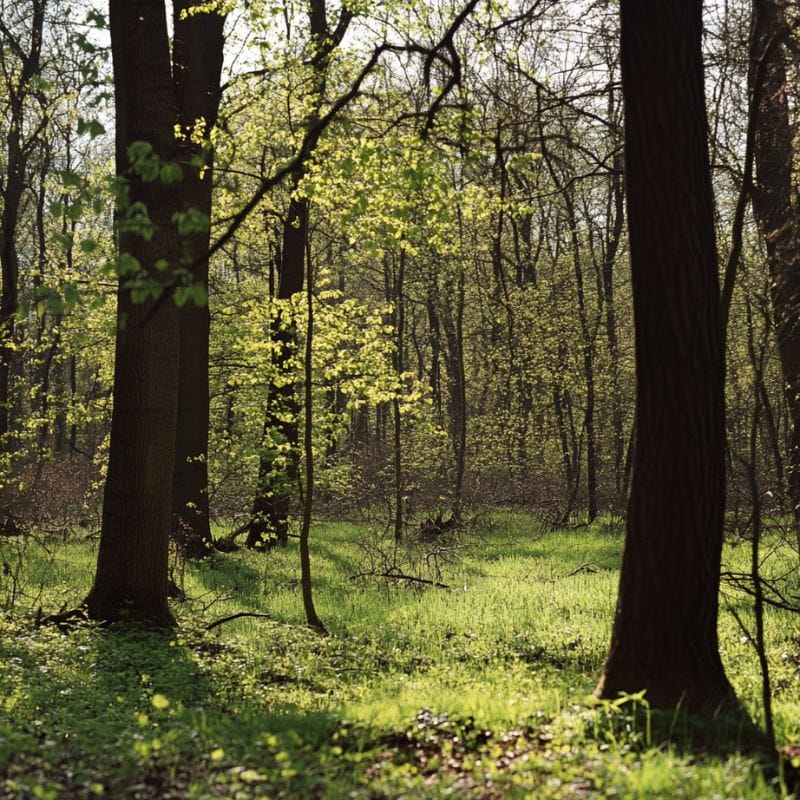
Morel mushrooms are known to show up in the spring, but exactly when is the question. The timing of morel season can vary, depending on the location, weather conditions, temperature, and various other factors.
In some areas, morels start emerging as early as the first few warm days after winter. If you’re in the southern United States, you might want to start morel hunting as early as March. If you’re in the northern parts of the country, such as the Midwest or the Northeast, you might have to wait until April to May.
Morels emerge later in the spring in some mountain regions, where morels season might continue up to early June. Typically, you can also expect fire morels to appear in the latter parts of spring.
Generally, you’ll want to hunt for morels a few days after some light rainfall, when temperatures start to get warmer. You can keep an eye on local weather forecasts, and you can also start checking soil temperatures if you haven’t done so yet. This can give you a much better idea of whether or not it’s time to put on your boots and start searching.
If you live in an area where wildfires occur, you might be able to start successfully searching for morels a day or two after a fire. However, keep in mind that other environmental conditions also need to be just right for morels to start fruiting. You might have to wait until later in the season, particularly in higher elevations.
It’s important to get the timing right! Morel season doesn’t last long, typically 4 to up to 8 weeks. This can also depend on a lot of different factors, many of which you can track and predict.
Thus, you need to make sure that you’re familiar with the topography and landscape of the area where you want to search, the weather, the environmental conditions, and the specific things that are conducive for morel growth. Make sure to get in early before all the good spots get wiped out!
As you head into peak season, it’s also worth learning about easy-to-identify wild nuts, seeds, and berries to round out your foraging haul.
One Final Disclaimer
The information provided in this article is for general informational and educational purposes only. Foraging for wild plants and mushrooms involves inherent risks. Some wild plants and mushrooms are toxic and can be easily mistaken for edible varieties.
Before ingesting anything, it should be identified with 100% certainty as edible by someone qualified and experienced in mushroom and plant identification, such as a professional mycologist or an expert forager. Misidentification can lead to serious illness or death.
All mushrooms and plants have the potential to cause severe adverse reactions in certain individuals, even death. If you are consuming foraged items, it is crucial to cook them thoroughly and properly and only eat a small portion to test for personal tolerance. Some people may have allergies or sensitivities to specific mushrooms and plants, even if they are considered safe for others.
Foraged items should always be fully cooked with proper instructions to ensure they are safe to eat. Many wild mushrooms and plants contain toxins and compounds that can be harmful if ingested.


